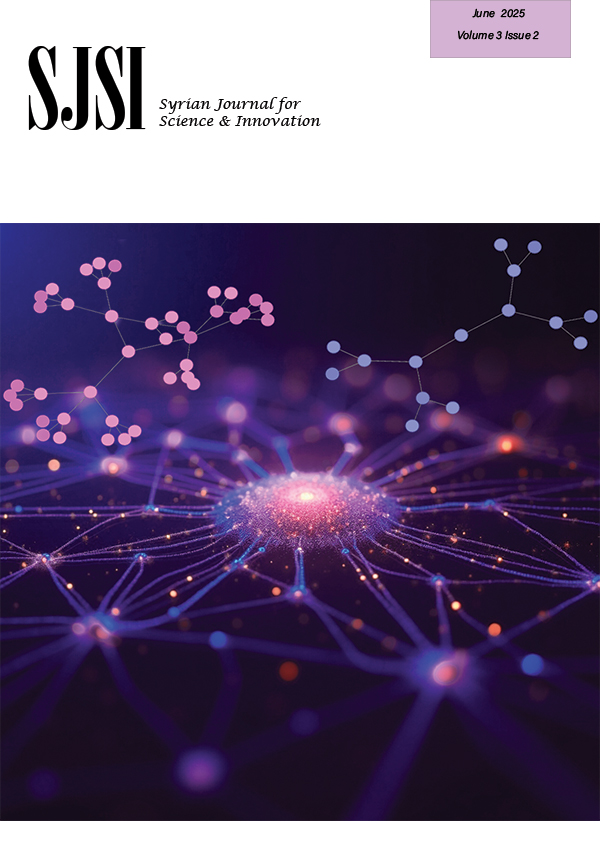Isolation and Characterization of Pathogenic Bacteria in Some Samples in Homs Governorate [Arabic]
2023-11-27 | Volume 1 Issue 3 - Volume 1 | Research Articles | Nariman NemaAbstract
In the framework of this study, 13 samples of well water were collected from the Governorate of Homs (Al-Arman Al-Janoubi, two samples from Wadi Al-Dahab, Al-Zahra), and from the countryside (Al-Jabriya, Al-Awar, two samples from Zaidal, Qatina, Al-Dar Al-Kabira, Jandar, Al-Mushrifa, Al-Madabae). Our aim was to detect the presence of Salmonella, Shigella, E.coli, Klebsiella, Pseudomonas, and Listeria bacteria in well water, based on a set of cultural and microscopic characteristics and some biochemical tests through the use of the three-test method (probabilistic, confirmatory and complementary test ) and the membrane filter method. The results of the probabilistic test for well water samples taken from (Al-Jabriya, Al-Awar, two samples from Zaidal, Qatina, Al-Dar Al-Kabira, two samples from Wadi Al-Dahab, Al-Mushrifa, Al-Madabae, and Al-Zahra) showed the appearance of gas in the Durham tubes after 48 hours of incubation, which indicates the possibility of contamination bacteria belonging to the coliform group. Confirmatory and complementary tests showed the appearance of smooth, metallic-glossy colonies on eosin medium, methylene blue short, gram-negative bacilli belonging to E.coli, which indicated that they are not suitable for drinking and irrigating crops. In the samples of Jandar and Al-Arman Al-Janoubi, no gas appeared after 48 hours of incubation, which indicated that they are suitable for drinking and irrigating crops. When using the membrane filtration method, we found that all studied samples were contaminated with the genus Klebsiella, except for the samples of Jandar and Al-Arman Al-Janoubi, which were also found to be free of pathogenic bacteria Salmonella, Shigella, Pseudomonas, Listeria, unlike the rest of the studied samples.
Keywords : Well Water, Pathogenic Bacteria, Governorate of Homs.
References :
- Sim TS, Duraka BJ. Biot Micren Coliphage counts: Are they necessary to maintain drinking water safety. Biot Micren J. Appl. Microtech. 1987 5: 223-226.
- Abera S, Zeyinudin A, Kebeda B, Deribrw A, Ali S, Zemene E. Bacteriological analysis of drinking water source. Afr. J. Microbiol. Res. 2011, 5(18):2638-2641.
- Hobson RP, Mackenzie FM, Gould I.M. An outbreak of multiply-resistant Klebsiella pneumoniae in the grampian region of Scotland. J. Hosp. Infect. 1996 33(4):249-262..
- Benson, HJ. Microbiological Application. 8th ed. McGraw-Hill, Companies, Inc., USA. 2002.
- Standard methods for the examination of water & waste water. 21th ed. Publishers, USA 2005.
- John BK, Rose AM, Raida S, Yvette JJ, Dennis G, Joseph CG. Consideration when using discriminate function analysis of antimicrobial resistance profiles to identify sources of fecal contamination of surface water in Michigan, Appl. Environ. Microbiol. 2007 73(9):2878-2890.
- Christian W, Thomas H, Gerhand K, Robert LM, Ansrease HF. Longitudinal chanes in the bacteria community composition of the Danube River: a whole-River Approach. Appl. Environ. Microbiol. 2007 73(2):421-431.
- Wagner E. Membrane filtration Handbook, practical tips and hints, second edition, revision 2.
- Lennet, EH., Balows A, Hausler WJ, Shadomy H.J. Manual of clinical microbiology. Soc. of Microbiology Washington. D.C. 1985.
- Hawkey PM, Lewis DA. Medical bacteriology: A practical approach. IRL Press. Oxford. 1989.
- Karnwal A, Dohroo A, Amin-ul Mannan M. Microbial analysis of potable water and its management through useful plant extracts, International Journal of Sciences and Research 2017 73 (3): 44-49.
- McGraw-Hill, Yearbook of Science & Technology 1st Edition 2004.
- Gartley S, Anderson-Coughlin B, Sharma M, Kniel KE. Listeria monocytogenes in irrigation water: An assessment of outbreaks, sources, prevalence, and persistence. Microorganisms 2022 10: 1319-1332.
- Berezin B. Nosocomial infections: Nosocomial infections: New agents, incidence, Prevention, Press- Med. 1995 24(2):89 -97.
- Mena KD, Gebra CP. Risk assessment of Pseudomonas aeruginosa in water, Review of environmental contamination and toxicology, 2009 201:71-115.
- El–Shenawy MA, El–Shenawy MA. Listeria spp. in the coastal environment of the Aqaba Gulf, Suez Gulf and the Red Sea. Epidemiology Infection 2006 134(4):752-757.
- Guzel M, Moreira RG, Omac B, Castell-Perez ME. Quantifying the Effectiveness of Washing Treatments on the Microbial Quality of Fresh-Cut Romaine Lettuce and Cantaloupe. LWT. 2017: 86, 270–276.
- Macgowan, AP, Bowker K, Mclauchlin J, Bennett PM, Reeves DS. The occurrence and seasonal changes in the isolation of Listeria Spp. in shop bought food stuffs, human faeces, sewage and soil from Urban sources. Int. J. Food Microbiol. 1994 21:325–334.
- Stea EC, Purdue LM, Jamieson RC, Yost CK, Hansen LT. Comparison of the prevalences and diversities of Listeria species and Listeria monocytogenes in an Urban and a rural agricultural watershed. Appl. Environ. Microbiol. 2015 81:3812–3822.
(ISSN - Online)
2959-8591

